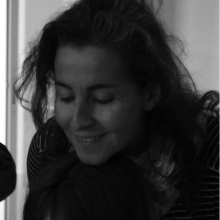LabFon - Laboratory of Phonetics and Phonology
The Phonetics and Phonology Lab (LabFon - Laboratório de Fonética e Fonologia) is a research group that was founded in the 1960s in the Faculty of Letters of the University of Lisbon. In 2005-2006 the group became a part of Onset (Center for Language Studies, FLUL) and in 2007 the group has joined the Center of Linguistics of the University of Lisbon. In line with the past history of the Lab, nowadays LabFon pursues its activities with three aims: (1) research (especially laboratory-phonology oriented), (2) education/training (at the undergraduate and graduate levels), and (3) services to the community.
In the last three years, two main lines of research have been developed: the study of frequency patterns in the phonology and phonetics of the language, and the study of the production and perception of prosody (prosodic phrasing, intonation, and rhythm).
Knowledge of frequency patterns has been shown to be crucial to the characterization of language usage, the establishing of lexical representations, or the emergence and development of grammar. Available frequency data for phonological units and patterns in Portuguese was scarce, non-replicable and corpus dependent. The line of research initiated in 2007 aimed at providing large-scale frequency information for phonological units and patterns from the feature to the prosodic word level, together with tools and databases, that allowed a description of Portuguese from the frequency perspective and enabled to test hypothesis about frequency effects in adult and child grammar, as well as language processing.
European Portuguese is one of the languages which is particularly interesting to the study of prosody and of the perception and production of prosodic properties. This is due to the fact that (i) European Portuguese is different from other Romance languages in terms of the properties it displays in various prosodic levels, such as the Prosodic Word or the Phonological Phrase, (ii) its intonation stands out from the rest of the Romance languages due to the scarcity of pitch accents and its overall prosodic phrasing, and (iii) it has a rare combination of syllabic and accentual rhythmic properties, within Romance. The presence of both Romance and Germanic-like properties in the prosody of the language raises challenging questions for language acquisition (under the prosodic bootstrapping hypothesis) and for language typology. The research developed at LabFon aims at tackling some of these questions in the broader context of cross-linguistic research, focusing on prosodic variation, the acquisition of prosody and the role of prosody in language development and language processing. To this end, the group set up in 2010 the Lisbon Baby Lab.
Membros
Integrated members with PhD
Integrated members without PhD
Colaboradores
Concluded
| Project | Date | Fin. |
|---|---|---|
| Horizon 21 - Horizon 21: Early language development in Down Syndrome | - | FCT
|
| EBELa - EBELa - Eyes and Brain: Early markers of Language Development | - | FCT
|
| InAPoP - InAPoP - Interactive Atlas of Prosody of Portuguese | - | FCT
|
| DEPE - DEPE - Development of Prosodic Structure and Intonation | - | FCT
|
| FreP - Frequency patterns of Phonological Objects in Portuguese: Research and Applications | - | FCT
|
| IntPhraRo - Intonational Phrasing in Romance |
| Resources | Type |
|---|---|
| A production lexicon of child speech for European Portuguese - PLEX5 | Lexicon |
| CDI-PE App: Aplicação online para avaliação de competências de linguagem e seu desenvolvimento - CDI-PE App | Tool |
| First Year Inventory - FYI | Database |
| Infant-Toddler Checklist from Communication and Symbolic Behavior Scales Developmental Profile - CSBS DP | Tool |
| Interactive Atlas of the Prosody of Portuguese Webplatform - InAPoP | Atlas |
| LumaLiDaOnLexicon | Lexicon |
| MacArthur Bates Communicative Inventories (CDI) for European Portuguese – Short Forms | Database |
| Quantitative Checklist for Autism in Toddlers - Q-CHAT-10 | Tool |
| Romance Languages Database: Online database for intonational phrasing in Romance - RLD | Database |
| Tools for the Transcription of Portuguese Prosody - P-ToBI | Tool |
. (2018). A Percepção das interrogativas globais entre variedades do Português do Brasil. Filologia E Linguística Portuguesa, 20(Especial), 11-25. http://doi.org/10.11606/issn.2176-9419.v20iespecialp11-25 |
. (2017). The role of intonation and visual cues in the perception of sentence types: Evidence from European Portuguese varieties. Laboratory Phonology: Journal Of The Association For Laboratory Phonology, 8(1), 23. http://doi.org/10.5334/labphon.110 |
. (2017). Prosodic development in European Portuguese from childhood to adulthood. Applied Psycholinguistics, 38(5), 1045-1070. http://doi.org/10.1017/s0142716417000030 |
. (2017). Automatic Quantification of Abbreviations in Medicine Package Leaflets and Their Comprehension Assessment. International Journal Of E-Health And Medical Communications, 8(2), 47-64. http://doi.org/10.4018/ijehmc.2017040104 |
. (2016). Infant communicative development assessed with the European Portuguese MacArthur–Bates Communicative Development Inventories short forms. First Language, 36(5), 525-545. http://doi.org/10.1177/0142723716648867 |
. (2016). Surface and Structure: Transcribing Intonation within and across Languages. Laboratory Phonology, 7(1), 7. http://doi.org/10.5334/labphon.10 |
. (2016). Dysarthria in individuals with Parkinson's disease: a protocol for a binational, cross-sectional, case-controlled study in French and European Portuguese (FraLusoPark). Bmj Open, 6(11), e012885. http://doi.org/10.1136/bmjopen-2016-012885 |
. (2015). Infants’ Perception of the Intonation of Broad and Narrow Focus. Language Learning And Development, 12(1), 1-13. http://doi.org/10.1080/15475441.2015.1020376 |
. (2015). Affective prosody in European Portuguese: Perceptual and acoustic characterization of one-word utterances. Speech Communication, 67, 58-64. http://doi.org/10.1016/j.specom.2014.09.007 |
. (2018). Using an Automatic Tool to Identify Potential Readability Issues in a Large Sample of Medicinal Package Inserts. Methods Of Information In Medicine, 54(04), 379-381. http://doi.org/10.3414/me15-04-0003 |
. (2015). Abbreviations and Symbols in a Large Sample of Medicinal Package Leaflets: Automatic Detection and Comprehension Assessment. Procedia Computer Science, 64, 683-690. http://doi.org/10.1016/j.procs.2015.08.585 |
. (2017). Basic research in phonology, resources and applications – the case of frequency. Cadernos De Estudos Linguísticos (Edição Em Homenagem A Bernadete Abaurre, Ed. By F. Sandalo And M. Rochel). A1 (Fonte: Qualis-Capes2013), 59 (3), 7-24. |
. (2016). The emergence of early word segmentation abilities in typically developing infants and infants with Down syndrome. Revista De Neurología , 62, (C01): C267. |
. (2015). A Stress “Deafness” Effect in European Portuguese. Language And Speech, 58(1), 48-67. http://doi.org/10.1177/0023830914565193 |
. (2015). Melodia ou Texto? Estratégias de acomodação entre melodia e texto em Português. Diadorim , 17 (2), 12-33. |
. (2015). Phonologically Constrained Variability in L1 and L2 Production and Perception. Phonetica, 72(2-3), 69-75. http://doi.org/10.1159/000441730 |
. (2010). Processos fonológicos aos cinco anos de idade: tipologia e frequência. Cadernos De Saúde , 3, Lisboa: Instituto de Ciências da Saúde,UCP. |
. (2015). Experimental Approaches to the Production and Perception of Prosody. Language And Speech, 58(1), 3-7. http://doi.org/10.1177/0023830914565287 |
. (2013). Book review: Toni Borowsky, Shigeto Kawahara, Takahito Shinya and Mariko Sugahara (eds.) (2012). Prosody matters: essays in honor of Elisabeth Selkirk. (Advances in Optimality Theory.) Sheffield & Bristol, Conn.: Equinox. Pp. xv+528. Phonology, 30(1), 165-172. http://doi.org/10.1017/s0952675713000067 |
. (2021). (Dys)Prosody in Parkinson’s Disease: Effects of Medication and Disease Duration on Intonation and Prosodic Phrasing. Brain Sciences, 11(8), 1100. http://doi.org/10.3390/brainsci11081100 |
. (2021). Communicative gestures in 7–12‐month infants: A phylogenetic comparative approach. Infant And Child Development. http://doi.org/10.1002/icd.2262 |
. (2022). Presentation. Prosody And Interfaces. Special Issue Of Delta: Documentação De Estudos Em Lingüística Teórica E Aplicada, 38(3), 1-14. http://doi.org/10.1590/1678-460X202259091 |
. (2022). Early Word Segmentation Behind the Mask. Frontiers In Psychology, 13:879123. http://doi.org/10.3389/fpsyg.2022.879123 |
. (2023). Editorial: Language Across Neurodevelopmental Disorders. Frontiers In Psychology. http://doi.org/https://doi.org/10.3389/fpsyg.2022.1121997 |
. (2022). Prosody and Interfaces. Special Issue of DELTA: Documentação de Estudos em Lingüística Teórica e Aplicada, 38(3). http://doi.org/10.1590/1678-460X202259091 |
. (2020). CDI-PE App: Aplicação online para avaliação de competências de linguagem e seu desenvolvimento baseada no MacArthur-Bates CDI para o Português Europeu Formas Reduzidas. ISBN 978-989-54771-1-1. |
. (2017). Questionário de Preocupações sobre o Desenvolvimento. Versão para o Português Europeu de Developmental Concerns Questionnaire , version 1.4 © Reznick, Baranek, Watson & Crais (2005). Chapel Hill: The University of North Carolina . |
. (2017). QUESTIONÁRIO PARA O PRIMEIRO ANO DE VIDA. Versão para o Português Europeu de FYI–FIRST YEAR INVENTORY ©2003 by Baranek, Watson, Crais, & Reznickc. |
. (2017). CHAT-10 Quantitative Checklist for Autism in Toddlers / Q-CHAT-10 Checklist Quantitativa para Autismo. em Crianças Pequenas. Tradução para o Português. Retrieved from https://www.autismresearchcentre.com/tests |



























